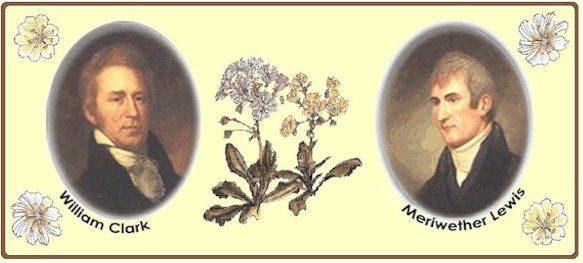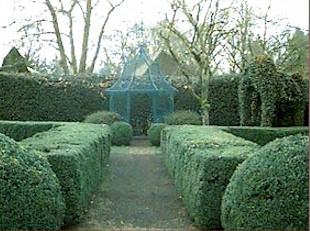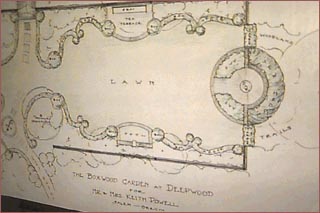WALLACE W HANSEN
Native Plants of the Northwest
Native Plant Nursery & Gardens
2158 Bower Ct S.E., Salem, Oregon 97301 E-Mail:
Wallace W Hansen
PHONE (503)581-2638 FAX(503)581-9957

WALLACE W HANSENNative Plants of the NorthwestNative Plant Nursery & Gardens2158 Bower Ct S.E., Salem, Oregon 97301 E-Mail:
Wallace W Hansen |

|
| Information about Wallace W Hansen Northwest Native Plant Nursery & Gardens: Business Information (Ordering, etc.) | |
Updated May 5, 2003 |
Wallace Hansen Celebrates Lewis and Clark |
|
|

 
|
Botanical Discoveries of the Lewis and Clark ExpeditionChoke Cherry (Prunus virginiana)"Near the beaver bents on the Missouri", August 10, 1806 On this date Captain Lewis spent most of the day at his camp in Williams County, North Dakota, and late in the afternoon his party floated down the Missouri River to a camp near present-day Williston in McKenzie County to a point a little above the Little Muddy River. The next day they continued down the river with occasional stops to hunt. Around noon, Lewis went elk hunting and was shot in the thigh by one of his men. The wound was dressed and the group made camp just above the mouth of the White Earth River in Mountrail County. On August 12, Lewis writes:
He gives a detailed description of the plant. Taking into consideration the specimen label as well as the journal entry, Lewis probably had one of his men collect the specimen on August 12, 1806 just down river from the mouth of White Earth River in Mountrail County, North Dakota. The site is now under Garrison Reservoir. This would be Lewis's last entry into a journal for the remainder of the trip. |
Recent photograph
Photo of Clark's specimen |
|
Clark also describes the species in his journal on August 10, 1806.
Moulton believed Clark probably took his description from Lewis's journal.
On that date - the one given on the label - Clark states "I found a
Species of Cherry in the bottom the Srub or bush which are different from
any which I have ever Seen and not very abundant even in the Small tract
of country." This "Small tract of country" is the same area
Lewis would travel through on August 11. We are not sure the specimen we
have was gathered by Clark or one that Lewis had someone gather for him,
and so are not sure of the exact location where the specimen was
collected.
However the specimen was collected and by whom, we are thankful they found it and that it was entered into the list of known plants. In modern times, we are still enjoying the same beauty and delicious fruit known to be a favorite of native peoples as well as bears and other wildlife for centuries. This beautiful Northwest Native tree is included at a very special low price during our Spring Sale. |
|
At this time in 1806:The following entry from Captain Lewis' journal on May 5, 1806, could be subtitled "a day in the life of a member of the Corps of Discovery." As do almost all the journal writings, we can see what was really happening in an up-close and personal way. We do well to remember that we are reading the thoughts of a person who was traveling cross country under hardships we can only imagine and through lands not before seen by white men. The impressions we read about reflect the events of the day as well as the paticular ideas and mind-set of the writer.
All this in one day on the trail. Hard to imagine for us today but then, a day in our lives would have been surreal to Captain Lewis as well--electricity, plumbing, cars, television, cooking stoves, etc. Our manner of dress would doubtless caused raised eyebrows also. |
Current events: |
|
|
If
you're in the area of Columbia, Missouri, the first part of May, 2003,
don't miss this outstanding event!
Columbia, Missouri • May 2, 3 and 4, 2003 World
Premiere
Cast
and Action of
Corps of Discovery, A Musical Journey By Michael Ching and Hugh Moffatt Pamela Legendre, Artistic Director Commissioned by MU Show-Me Opera University of Missouri-Columbia Cast: Other
characters: ACT
I – Camp Dubois to Fort Mandan
(December 1803 to April 1805) ACT
II – Fort Mandan to the Pacific
(Summer to Christmas Day 1805) ACT
III – The Death of Lewis
(Oct. 11, 1809) For information on booking the three-act Show-Me Opera production or the 45-minute smaller stage version; for rental or purchase of orchestral score and parts; and for rental or purchase of piano/vocal score and other options, please contact:
The
Creative Team of Michael
Ching,
Composer Hugh
Moffatt,
Librettist Pamela
Legendre,
Artistic Director |
|
|
|
|
|
The Corps of Discovery II Lewis and Clark Traveling Exhibit Beginning it's 4-year tour, stopping at communities along the trail that the Corp of Discovery took during the three years and eight months it took to make their journey. The exhibit will end in Oregon. The exhibit consists of a 53-foot long trailer carrying two tents, a stage, chairs, lighting, sound and visual gear and heating and air-conditioning equipment. One tent will hold an audio tour of replicas of historical paintings depicting the expedition's main characters and the landscapes they saw. Guided and sponsored by the following organizations: Library Associations of Washington D.C., Virginia, West Virginia, Maryland, Pennsylvania, Ohio, Kentucky, Indiana, Illinois, Missouri, Iowa, Kansas, Nebraska, South Dakota, North Dakota, Montana, Idaho and Oregon - which collectively comprise Trail States Library Associations - and the U.S. National Park Service (NPS). |
|
|
|
|
|
Deepwood Estate Museum 1894 Queen Anne Style Home Salem, Oregon Landscape architects Elizabeth Lord and Edith Schryver were commissioned by Alice Brown to create the formal gardens at Deepwood Estate. Lord and Schryver were the first formally trained women landscape architects in the Northwest. Pictured at right, top, is the 1905 Lewis & Clark Gazebo acquired by Mrs. Brown and sited at Deepwood in 1949. Below is an architectural drawing of the grounds at Deepwood. Deepwood is the most significant example of landscape architects Elizabeth Lord and Edith Schryver's Northwest work. It is their only garden design that is open to the public. Intriguing features at Deepwood include a scroll garden with a hidden signature, an ivy tunnel and a pastel tea garden. There are three other superb examples of their designs in the area, but they are associated with private residences.
|

|
|
Visitor Information 1116 Mission Street SE Salem, Oregon 97302
Deepwood grounds open dawn to dusk daily at no charge. Deepwood House Tours are 12:00-5:00 pm. hourly, May thru September, Sunday-Friday; October thru April, Tuesday-Saturday Admission: Adults, $4.00/Students and Seniors, $3.00/Children, $2.00 (under six - free)
http://www.oregonlink.com/deepwood/ House Tour Information: 503-363-1825 |

|
|
|
|
|
PICTURING THE CORPS OF DISCOVERY: The Lewis and Clark Expedition in Oregon Art An exhibit at the State Capitol building Presented by Oregon Historical Society |
|
|
December
20, 2002 through December 2004
State Capital building, 900 Court Street NE, Salem, Oregon 8 a.m. - 5 p.m. Monday - Friday 12 p.m. - 4 p.m. Saturday Closed - Sunday |
|
|
"Picturing
the Corps of Discovery demonstrates how artistic interpretations of the
Lewis and Clark Expedition mirror the history and evolving values of
Americans, and more specifically Oregonians, over the past two centuries.
Viewers will be introduced to works of art with Lewis-and-Clark themes
that reflect changing understandings of topics as diverse as democratic
ideals, ethnicity, and the environment.
A collection of images of Lewis and Clark pointing westward, including Frank Schwarz's treasured 1938 mural in Oregon's Capitol rotunda, demonstrate how the two explorers were credited with introducing civilization to the West well into the first half of the twentieth century. By the end of the century, however, works like Michael Florin Dente's 1988 sculpture, The Naming of Mount Jefferson, at the University of Portland, celebrated the expedition's ethnic mix as a historical precedent for a multicultural, pluralistic society in the West." http://www.ohs.org/exhibits/picturing-the-corp-of-discovery.cfm |
|
|
|
|
Back Issues:To see back issues of Wallace Hansen Celebrates Lewis and Clark, click on this link to jump to the index. |
|
Commemorative Painting by Heidi Hansen:The illustrated map below was created by renowned botanical artist Heidi D. Hansen especially for this website. Done in ink and watercolors, Heidi shows many of the plants Captain Lewis documented overlaid atop a map showing a portion of the journey. (Click on image for large view). |
|
|
|
|
|
|
|
|
|
|
|
|
|
|
Click here to return to my Home Page |
|
Questions about plants, click here: Regular Email to Wally To order, click here: Secure Email to Wally |
|
|
Comments or questions about our web site, click here: Webmaster |